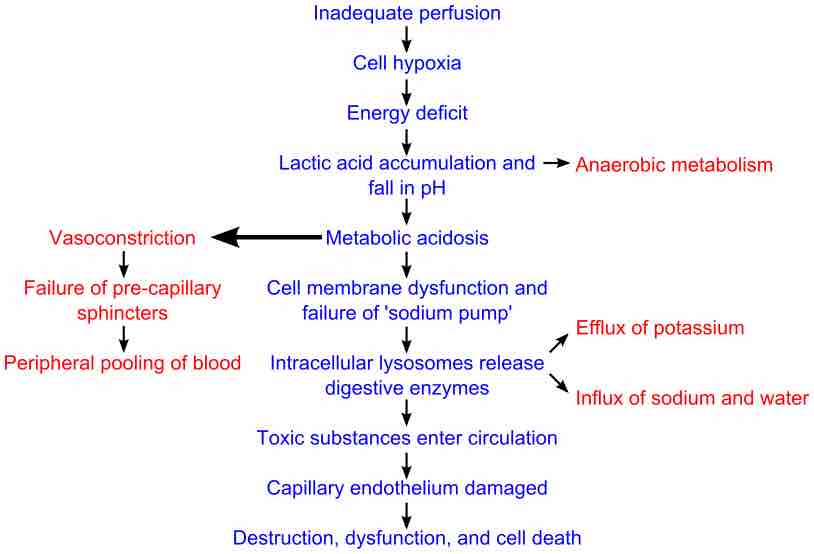Circulatory shock, commonly known simply as shock, is a life-threatening medical condition that occurs due to inadequate substrate for aerobic cellular respiration. In the early stages this is generally an inadequate level of oxygen in the tissues.

Shock
The scheme depicts the cell metabolic response as a result of inadequate blood delivery during circulatory shock.
There are four stages of shock. As it is a complex and continuous condition there is no sudden transition from one stage to the next.
Initial Stage
During the initial stage, the state of hypoperfusion causes hypoxia. Due to the lack of oxygen, the cells perform anaerobic respiration. Since oxygen is not abundant, the Kreb's cycle is slowed, resulting in lactic acidosis (the accumulation of lactate).
Compensatory Stage
The compensatory stage is characterized by the employment of neural, hormonal, and biochemical mechanisms in the body's attempt to reverse the lactic acidosis. The increase in acidity will initiate the Cushing reflex, generating the classic symptoms of shock. The individual will begin to hyperventilate to rid the body of carbon dioxide to raise the blood pH (lower the acidity). As a result, the baroreceptors in the arteries detect the hypotension and initiate the release of epinephrine and norepinephrine to increase heart rate and blood pressure.
Progressive Stage
Should the cause of the crisis not be successfully treated, the shock will proceed to the progressive stage, in which the compensatory mechanisms begin to fail. As anaerobic metabolism continues, increasing the body's metabolic acidosis, the arteriolar smooth muscle and precapillary sphincters relax. Blood remains in the capillaries, leading to leakage of fluid and protein into the surrounding tissues. As fluid is lost, blood concentration and viscosity increase, causing blockage of the microcirculation. The prolonged vasoconstriction will also cause the vital organs to be compromised due to reduced perfusion. If the bowel becomes sufficiently ischemic, bacteria may enter the blood stream, resulting in the additional complication of endotoxic shock.
Refractory Stage
At the refractory stage, the vital organs have failed and shock can no longer be reversed. Brain damage and cell death are occurring, and death is imminent. Shock is irreversible at this point since a large amount of cellular ATP has been degraded into adenosine in the absence of oxygen as an electron receptor in the mitochondrial matrix. Adenosine easily perfuses out of cellular membranes into extracellular fluid, furthering capillary vasodilation, and then is transformed into uric acid. Because cells can only produce adenosine at a rate of about 2% of the cell's total need per hour, even restoring oxygen is futile at this point because there is no adenosine to phosphorylate into ATP.